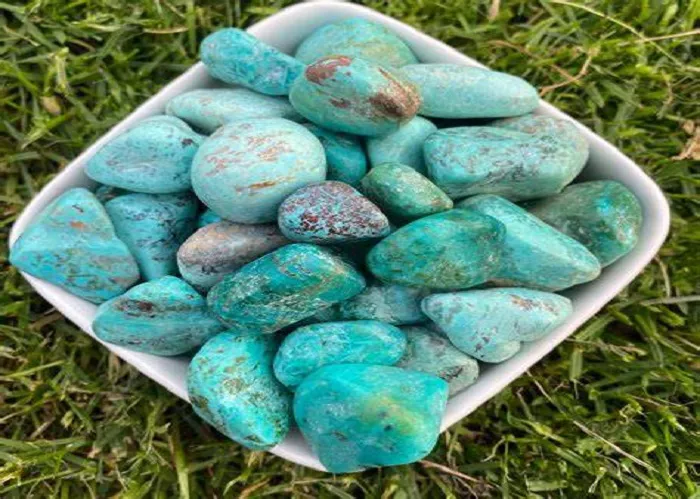Turquoise is one of the most beloved gemstones in the world. Its vibrant blue and green hues have captivated people for centuries. But not all turquoise is equal in value. Some colors are rarer and more sought-after than others. So, what is the most expensive color of turquoise?
In this article, we will explore the different colors of turquoise, what makes them valuable, and why certain shades command higher prices. We will also discuss famous turquoise mines, how color affects pricing, and tips for identifying high-quality turquoise.
Understanding Turquoise Colors
Turquoise gets its color from trace minerals in its chemical composition. The two main elements that influence its hue are copper (which creates blue tones) and iron (which adds green tones). The most valuable turquoise has a pure, intense color with minimal impurities.
Here are the 5 most common color variations of turquoise:
- Robin’s Egg Blue (Sky Blue) – The most prized color. It is a bright, pure blue with no green.
- Persian Blue – A slightly deeper blue, highly valued in Middle Eastern markets.
- Green Turquoise – Contains more iron, making it less expensive than blue varieties.
- Spiderweb Turquoise – Features dark veins (matrix) in a blue or green base.
- White Turquoise – Very rare, often mistaken for howlite when dyed.
Among these, Robin’s Egg Blue and Persian Blue are the most expensive.
Why Is Robin’s Egg Blue Turquoise the Most Expensive?
Several factors make Robin’s Egg Blue the most valuable turquoise color:
Rarity
The purest blue turquoise is rare. Most turquoise has some green or brown matrix (veining).
Mines producing this color (like Sleeping Beauty in Arizona) are mostly depleted.
High Demand
Jewelry designers and collectors prefer this bright, clean blue.
It matches well with silver and gold settings.
Historical Significance
Ancient Persians and Egyptians prized pure blue turquoise for royal jewelry.
Native American tribes, like the Navajo and Zuni, used it in sacred art.
No Treatments Needed
Many turquoise stones are stabilized (hardened with resin) to improve durability.
The finest Robin’s Egg Blue turquoise is often natural and untreated, increasing its value.
Other Expensive Turquoise Colors
While Robin’s Egg Blue is the top choice, other rare colors also fetch high prices:
Persian Blue Turquoise
Comes from Iran (historically called “Persia”).
Has a slightly deeper blue tone than Robin’s Egg Blue.
Highly sought after in luxury jewelry.
Spiderweb Turquoise
Not a color, but a pattern.
Dark veins (matrix) create a unique “spiderweb” effect.
The best examples have a bright blue base with thin, even webbing.
Lime Green Turquoise
A rare bright green variety, found in a few mines like Nevada’s Carico Lake.
Less common than blue, making it valuable in designer jewelry.
How Mines Affect Turquoise Color and Value
The location where turquoise is mined greatly impacts its color and price. Some of the most famous turquoise mines include:
Sleeping Beauty Mine (Arizona, USA)
Produced the famous Robin’s Egg Blue turquoise.
Now closed, making its stones even more valuable.
Nishapur District (Iran)
Source of Persian Blue, the finest turquoise for centuries.
Iranian turquoise is still among the most expensive.
Kingman Mine (Arizona, USA)
Known for bright blue and green turquoise.
Often used in Native American jewelry.
Carico Lake Mine (Nevada, USA)
Produces rare lime green and blue-green turquoise.
Highly collectible due to its unique color.
How to Identify High-Quality Turquoise
If you want to buy expensive turquoise, look for these qualities:
- Vibrant, Even Color – The best turquoise has no dull spots or uneven coloring.
- Minimal Matrix – Some collectors like spiderweb patterns, but pure blue is more valuable.
- Natural and Untreated – Stabilized turquoise is cheaper than natural, untreated stones.
- Good Hardness – High-quality turquoise should not scratch easily.
- Origin Matters – Turquoise from famous mines (like Persian or Sleeping Beauty) is worth more.
Fake vs. Real Turquoise: How to Spot the Difference
Because turquoise is valuable, some sellers try to pass off fake stones. Here’s how to tell real turquoise from imitations:
- Dyed Howlite or Magnesite – These white stones are often dyed to look like turquoise. Real turquoise has natural variations.
- Plastic or Resin Fakes – Fake turquoise feels lightweight and has no natural imperfections.
- Lab-Created Turquoise – Man-made versions lack the depth of natural stones.
Always buy from reputable dealers and ask for certification if unsure.
Conclusion
After examining all factors, Robin’s Egg Blue (Sky Blue) turquoise is the most expensive. Its pure, bright blue hue, rarity, and historical prestige make it the top choice for collectors and jewelers. Persian Blue is a close second, especially from Iran.
If you’re looking to invest in turquoise, focus on natural, untreated stones from famous mines. Whether you prefer the classic blue or a rare green variety, high-quality turquoise will always hold its value.
Would you choose a deep Persian Blue or a bright Robin’s Egg Blue turquoise? The choice depends on your taste—but now you know which color is truly the most valuable!
Related topics:
How Much is A Carat of Turquoise?
How to Wear Turquoise Necklace?
Why Are Small Turquoise Stud Earrings So Popular?


